How to install a hood if a gas pipe is in the way: instructions for the work
Installing a hood over a gas stove significantly improves the microclimate throughout the apartment.The smell of cooking food, steam with droplets of fat dissolved in it, and combustion waste do not spread throughout all rooms, but enter the ventilation or disappear due to filtration.
Installation of a built-in or wall-mounted structure is simple and does not require special skills or a lot of time. But sometimes the installation is complicated by the inconvenient location of communications - for example, a metal gas pipe running through the center of the wall.
In this article we will try to figure out how to install a hood over a gas pipe in order to maintain both the integrity of communications and the serviceability of the cleaning device. And at the same time, let us remind you what to do is strictly prohibited.
The content of the article:
Is it possible to move a gas pipe?
The absurd and technically unreasonable placement of pipes in the middle of the wall is not such a rare phenomenon. There are options that confuse new residents and nullify their plans to install kitchen furniture or appliances.
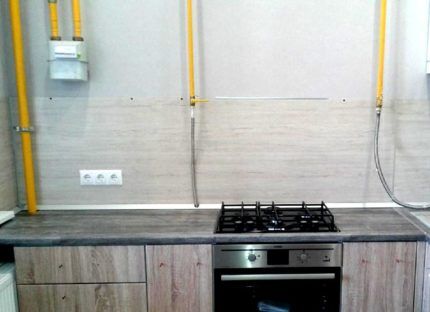
To expand the possibilities, the outlet is extended with a flexible hose - in this case, the gas stove can be installed at a distance of up to 2-3 m from the end of the metal structure.
If the riser is located not in the corner, but in the center, installation of the hood or furniture modules becomes more complicated.The same happens when the horizontal section of the pipe is located not below the table level, which is convenient for masking it, but at a height of more than 150 cm - that is, in a place where it can potentially be produced hood installation.
The horizontal outlet is usually moved, but this requires the approval of the gas service. Installation and welding work is also carried out by Gorgaz employees - it is prohibited to move gas communications yourself. The procedure is expensive and time-consuming, so it is advisable to undergo it, for example, when installing a gas meter.
The gas riser, like the ventilation hole, cannot be moved. The vertical metal pipe is part of the common house equipment, which should not be touched under any circumstances. This is prohibited by all regulatory documents, so it is better to think through the installation of the stove and the location of the hood in advance - just place them away from gas communications.
You can learn more about gas equipment in a residential building in SNiP 2.04.08-87* (in the current version).
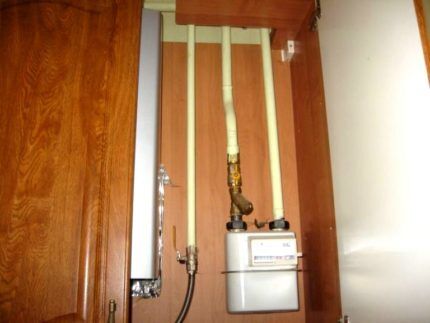
If the ventilation hole is located near the riser, it is not necessary to place the stove directly under it. There are many ways to connect it to the hood using a duct structure.
Conclusion: in order for the interior design not to suffer, the easiest way is to rearrange the stove together with the hood to another place. If finances allow and there is a desire, you can move the horizontal pipe section, but with the approval of the gas service.
And for those who don’t want to redo anything, we offer instructions on installing a hood on wooden blocks. This option is not the best from a technical point of view, but it can help out as a temporary solution or for installing an exhaust device in the country.
Instructions for installing a hood over a pipe
It is not customary to install powerful, expensive equipment on any unstable devices, so we choose the appropriate device - low-power, dome or mounted type.
A hood built into the cabinet will also work - then the module above the stove will protrude forward. This must be taken into account when choosing installation height, since the device should not interfere with cooking.
The simplest option is mounted hood with carbon filters.
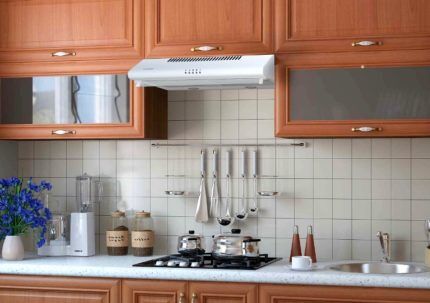
Other types of equipment are more powerful, heavier and more difficult to install, so they will require more time and skill to install.
So, let's move on to the instructions on how to hang a hood with your own hands if the gas pipe is in the way.
Step 1 - choosing an option for installing the hood
Considering that the gas pipe has a diameter of 40-50 mm and is located at some distance from the wall, we select the base material for attaching the hood. The thickness of this material should cover the communications so that after installation they are located behind the hood and do not come into contact with it.
In this regard, you can use the following materials or fastenings:
- wooden blocks;
- chipboard fragments;
- metal brackets;
- anchor fasteners with studs.
Attachments - studs or brackets - can create vibration and additional noise during equipment operation.
It is more expedient to create a base from bars, and then mount the device as if it were hung on a wooden wall.
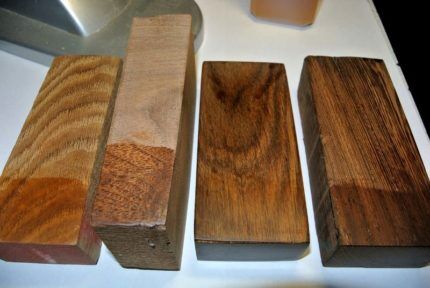
If the kitchen furniture is made of solid wood or “wood-like”, then the visible parts of the original “substrate”, combined with the interior, will not be noticeable.
Step 2 - preparing tools and marking
To work, you will need tools with which the bars can be prepared, processed, and then mounted on the wall, as well as materials for processing:
- saw or jigsaw;
- sandpaper;
- tape measure and pencil;
- antiseptic impregnation, varnish, paint;
- dowels and long screws;
- screwdriver.
Installation of the hood is easy: the kit includes a mounting kit, and to fix the device on the wall you only need a screwdriver. It is more difficult to secure the bars - you may have to drill into the wall if it is concrete. Then a cordless drill will come in handy.
When all the tools are at hand, you can start marking.
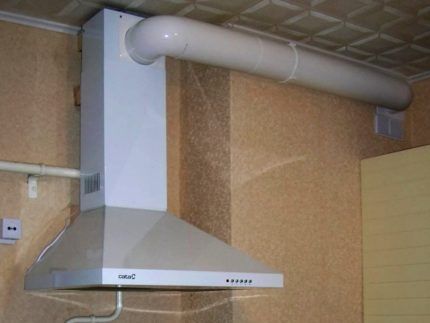
The most successful option is 2 bars attached to the sides of the pipe.
Very small blocks may not support the weight of the equipment or, over time, deform under the weight of the exhaust device.Too large sections will interfere with the installation of furniture and spoil the interior.
Having decided on the dimensions, we apply markings to the wall. The manufacturer's instructions will also help with this - it indicates at what distance from the stove it is recommended to hang the hood. Wooden supports must also be secured at the same distance.
Step 3 - processing and installation of wooden blocks
Having found out the dimensions of the bars, we take the board and saw off fragments of the required length. We trim them so that they match all dimensions. Then we place the finished parts against the wall and apply a hood to them - we check whether the pipe is completely blocked.
If everything is in order, we treat each bar with products that extend its service life. Wood is very loved by wood-boring beetles, and at high humidity it turns into a habitat for all kinds of microorganisms, fungi and mold.
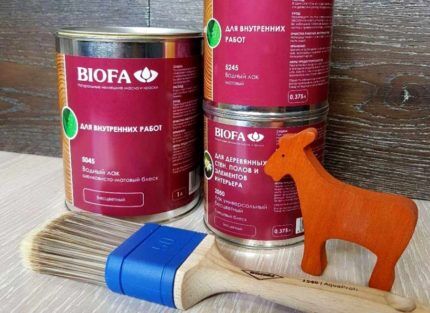
Before applying a protective layer to the bars, they should be thoroughly sanded with fine sandpaper, and the ends should be processed with a file and also cleaned. This way paint and varnish compositions adhere better and penetrate deeper into the wood structure.
When the paint or impregnation has dried, the bars need to be fixed on the wall - on both sides of the gas pipe.
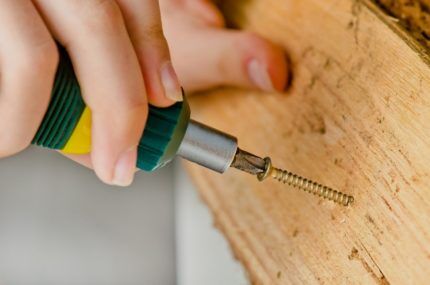
If you don't have self-tapping screws on hand, nails will do. But they are usually not used due to difficulties with dismantling.
Step 4 – installation of the hood on the bars
The last step must be performed strictly according to the instructions proposed by the manufacturer. Particular attention should be paid to the distance from the working surface of the slab before exhaust and method of fastening.
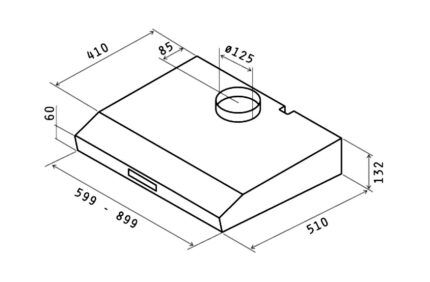
You need to imagine that two bars are the wall, the base for fixation. The principle of fastening is no different.
Please note that almost all hoods have a hole at the top for connecting the air duct. It can be useful if, instead of filtration, you use direct exhaust into the ventilation shaft.
To install the “visor” you will need 2 or 4 fasteners, for the “dome” - 4 or more. The fixation points are hidden under the body.
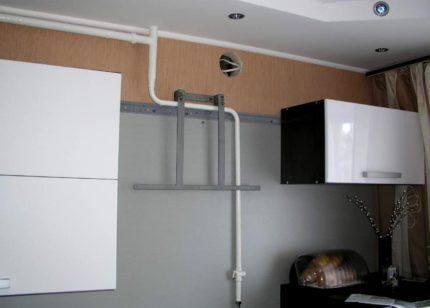
After installation, be sure to turn on the hood and check the reliability of the fastenings during operation. If strong vibration occurs, it is better to change it immediately - excess noise will interfere with being in the kitchen, and vibrations may affect the performance of the device.
One of the main conditions for a positive result is the absence of contact between the hood and the pipe.
Conclusions and useful video on the topic
The simplest method of mounting on bars, part 1:
The simplest method of mounting on bars, part 2:
Installation on anchors and studs:
The metal gas pipe and hood in the kitchen should not be in close proximity. If this does happen, the best solution would be to move the stove away from the gas pipeline.Installing an exhaust device on any devices is an additional risk, especially when the pipe is located near an open fire. We advise you to resort to this dubious method only as a last resort.
We also recommend that you consult a gas service specialist before starting any work. This will also serve as additional insurance if gas workers have questions in the future.
If you have already had to install a hood when a gas pipe is in the way, please tell our readers what difficulties you encountered during installation and how you managed to overcome the situation.



